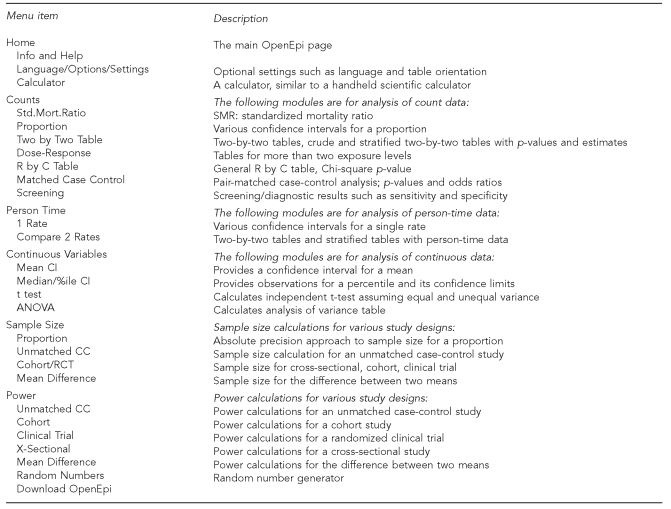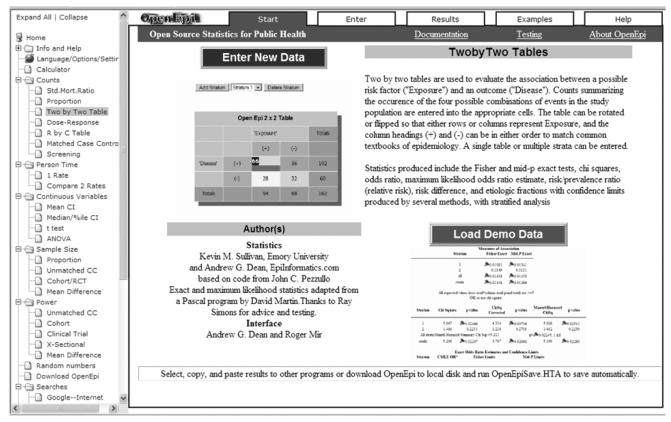During graduate training in public health, students are exposed to a number of epidemiologic and statistical formulae. Frequently, many of these may be initially calculated by hand with a calculator and then later using computer software. A number of commercial programs are available, many of which are taught in schools of public health (SPHs), such as SAS®, SPSS®, and Stata®. While they are probably the most commonly used commercial programs in epidemiology,1 and are incredibly powerful, they do have certain characteristics that limit their use in low- to moderate-resource situations: (1) they tend to be expensive beyond the reach of some SPHs worldwide, (2) they tend to be complicated to learn and use, (3) they have a number of hardware/computer requirements, and (4) user support may not be readily available.
Free epidemiologic programs, such as Epi Info (www.cdc.gov/epiinfo) and EpiData (www.epidata.dk), are also available. For some of the commercial and free programs mentioned, many epidemiologic parameters and statistical calculations taught in SPH courses are not provided in the programs. Because of the aforementioned limitations, we decided to develop a program to assist in teaching epidemiologic and statistical procedures.
INTRODUCTION TO OpenEpi
OpenEpi (www.OpenEpi.com) is a free, Web-based, open-source, operating system-independent series of programs designed for use in public health and medicine—for training or practice—that provide a number of epidemiologic and statistical tools for summary data.2–7 OpenEpi was developed in JavaScript and hypertext markup language (HTML) and can be run in browsers supporting these languages. Therefore, it can run under various Web browsers, such as Microsoft® Explorer, Firefox®, Safari, and Opera, and on a number of operating systems, such as Windows, Macintosh, and Linux. It can even run on an iPhone. The program can be run from the OpenEpi website or downloaded and run without a Web connection. The source code and documentation are freely downloadable and available for use by other investigators. The program is available in English, French, Italian, and Spanish.
The OpenEpi developers have had extensive experience in developing and testing Epi Info, a program developed by the Centers for Disease Control and Prevention (CDC) and used worldwide for data entry and analysis. OpenEpi was initially developed to perform analyses found in the disk operating system (DOS) version of Epi Info modules StatCalc and EpiTable, to improve on the types of analyses provided by these modules, and to provide a number of tools and calculations not currently available in Epi Info. It is the first step toward an entirely Web-based suite of epidemiologic software tools. We see OpenEpi as a useful companion to Epi Info and to other programs such as SAS, SPSS, Stata, and EpiData. OpenEpi, Epi Info, and EpiData were developed with the goal of providing simple tools for low- and moderate-resource areas of the world.
The initial development of OpenEpi was supported by a grant from the Bill and Melinda Gates Foundation to Emory University. OpenEpi has had more than 1.4 million hits from 160 countries since its inception in 2003 and almost 500,000 hits in the first six months of 2008. A recent Google search identified almost 5,000 sites mentioning OpenEpi.
ANALYTIC CAPABILITIES OF OpenEpi
The types of calculations currently performed by Open-Epi are shown in Figure 1 and include:
Various confidence intervals for proportions, rates, standard mortality ratio, mean, median, and percentiles
Two-by-two crude and stratified tables for count and rate data
Matched case-control analysis
Test for trend with count data
Independent t-test and one-way analysis of variance (ANOVA)
Diagnostic and screening test analyses with receiving operator characteristic (ROC) curves
Sample size for proportions, cross-sectional surveys, unmatched case control, cohort, randomized controlled trials, and comparison of two means
Power calculations for proportions (unmatched case control, cross-sectional, cohort, clinical trials) and for the comparison of two means
Random number generator
For epidemiologists and other health researchers, OpenEpi performs a number of calculations based on cross-tabulations not found in most epidemiologic and statistical programs. For example, for a single two-by-two table, in addition to the conventional results presented in other programs, OpenEpi provides estimates for:
Etiologic or prevented fraction in the population and exposed with confidence intervals, based on risk, odds, or rate data
The cross-product and maximum likelihood odds ratio estimate
Mid-p, exact p-values, and confidence limits for the odds ratio
Calculations of rate ratios and rate differences with confidence intervals and statistical tests
For stratified two-by-two tables with count data, OpenEpi provides:
Mantel-Haenszel and precision-based estimates of the risk ratio and odds ratio
Precision-based adjusted risk difference
Tests for interaction for the risk ratio, odds ratio, and risk difference
Four different confidence limit methods for the odds ratio
Figure 1.
OpenEpi menu with short descriptions of the modules
Similar to Epi Info, in a stratified analysis, both crude and adjusted estimates are provided so that the assessment of confounding can be made. With rate data, OpenEpi provides adjusted rate ratios and rate differences, and tests for interaction. Finally, with count data, OpenEpi also performs a test for trend, for both crude and stratified data.
An example of one of the modules is shown in Figure 2, which features five tabs. The “Start” tab provides an overview of the module. The “Enter” tab is where data entry is performed, or the user can click on the “Enter New Data” button. Results of the calculations are under the “Results” tab. A number of examples are provided under the “Examples” tab. And a “Help” tab is available to answer questions about the program. Other links on the screen include “Documentation,” which provides the analytic details, including formulae, used in the module; and “Testing,” which compares the results of the OpenEpi module to other software programs or to textbook examples. Many of the modules have a “Load Demo Data” button that will automatically load example data into the module.
Figure 2.
Example of “Start” page for two-by-two table module
USE OF OpenEpi IN TEACHING
To the developer's knowledge, OpenEpi has been used as a training tool for teaching epidemiology to students at Columbia University, Emory University, Morehouse College, San Jose State University, University of Medicine and Dentistry of New Jersey, University of Michigan, and University of Wisconsin, for campus-based and distance-learning courses. Because OpenEpi is easy to use, requires no programming experience, and can be run on the Internet, students can use the program and focus on the interpretation of results.
FUTURE DIRECTIONS FOR OpenEpi
While much has been accomplished, the investigators would like to enhance OpenEpi by (1) improving the existing programs; (2) adding new programs to perform epidemiologic, statistical, or nutritional calculations; (3) adding the ability to cut and paste and read data; (4) translating the program into additional languages; and (5) increasing the level of knowledge of OpenEpi worldwide. A number of prototype Open-Epi modules, including logistic regression and survival analysis, can be found at http://www.sph.emory.edu/∼cdckms. We invite others to develop and test new modules for OpenEpi.
REFERENCES
- 1.Sullivan K. Google search identifies programs epidemiologists use most. The Epidemiology Monitor. 2008;29:4. [Google Scholar]
- 2.Sullivan K, Abramson J. Update on free epidemiologic software. The Epidemiology Monitor. 2008;29:3–4. [Google Scholar]
- 3.Sullivan KM. OpenEpi now available in English, French, Italian, and Spanish. The Epidemiology Monitor. 2007;28:14. [Google Scholar]
- 4.Sullivan KM, Dean A, Soe MM. OpenEpi version 2. The Epidemiology Monitor. 2007;28(1):9–10. [Google Scholar]
- 5.Sullivan KM. Overview of free analytic software for epidemiologists. The Epidemiology Monitor. 2007;28:3–4. [Google Scholar]
- 6.Sullivan K, Dean A, Soe MM. OpenEpi: an update. The Epidemiology Monitor. 2006;27:4. [Google Scholar]
- 7.Sullivan KM, Dean AG, Mir R. OpenEpi: a new collaborative effort in epidemiologic computing. The Epidemiology Monitor. 2004;25:3, 7, 9. [Google Scholar]




